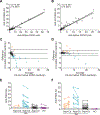Citrulline Not a Major Determinant in the Recognition of Peptidylarginine Deiminase 2 and 4 by Autoantibodies in Rheumatoid Arthritis
- PMID: 32255561
- PMCID: PMC7541452
- DOI: 10.1002/art.41276
Citrulline Not a Major Determinant in the Recognition of Peptidylarginine Deiminase 2 and 4 by Autoantibodies in Rheumatoid Arthritis
Abstract
Objective: Citrullinated proteins are hallmark targets of autoantibodies in rheumatoid arthritis (RA). Our study was undertaken to determine the effect of autocitrullination on the recognition of peptidylarginine deiminases (PADs) 2 and 4 by autoantibodies in RA.
Methods: Autocitrullination sites in PAD2 and PAD4 were determined by mass spectrometry and literature review. Antibodies against native and autocitrullinated PADs in 184 patients with RA were detected by enzyme-linked immunosorbent assay. Linear regression analysis, outlier calculations, and competition assays were performed to evaluate antibody reactivity to native and citrullinated PADs.
Results: Autocitrullination of PAD2 and PAD4 was detected in 16 (48%) of 33 arginine residues and 7 (26%) of 27 arginine residues, respectively. Despite robust autocitrullination, autoantibodies bound similarly to native and citrullinated PAD2 or PAD4 (ρ = 0.927 and ρ = 0.903, respectively; each P < 0.0001). Although subsets of anti-PAD-positive sera were identified as exhibiting preferential recognition of native or citrullinated PAD2 (40.5% or 4.8%, respectively) or PAD4 (11.7% or 10.4%, respectively), competition assays confirmed that the majority of anti-PAD reactivity was attributed to a pool of autoantibodies that bound irrespective of citrullination status.
Conclusion: Autocitrullination does not affect autoantibody reactivity to PADs in the majority of patients with RA, demonstrating that anti-PAD antibodies are distinct from anti-citrullinated protein antibodies in their dependence on citrullination for binding.
© 2020, American College of Rheumatology.
Figures



Similar articles
-
PAD enzymes in rheumatoid arthritis: pathogenic effectors and autoimmune targets.Nat Rev Rheumatol. 2020 Jun;16(6):301-315. doi: 10.1038/s41584-020-0409-1. Epub 2020 Apr 27. Nat Rev Rheumatol. 2020. PMID: 32341463 Review.
-
High-Titer Rheumatoid Arthritis Antibodies Preferentially Bind Fibrinogen Citrullinated by Peptidylarginine Deiminase 4.Arthritis Rheumatol. 2017 May;69(5):986-995. doi: 10.1002/art.40035. Arthritis Rheumatol. 2017. PMID: 28029744 Free PMC article.
-
Identification of potential autoantigens in anti-CCP-positive and anti-CCP-negative rheumatoid arthritis using citrulline-specific protein arrays.Sci Rep. 2021 Aug 27;11(1):17300. doi: 10.1038/s41598-021-96675-z. Sci Rep. 2021. PMID: 34453079 Free PMC article.
-
Protein Citrullination by Peptidyl Arginine Deiminase/Arginine Deiminase Homologs in Members of the Human Microbiota and Its Recognition by Anti-Citrullinated Protein Antibodies.Int J Mol Sci. 2024 May 10;25(10):5192. doi: 10.3390/ijms25105192. Int J Mol Sci. 2024. PMID: 38791230 Free PMC article.
-
Autoantibodies to protein-arginine deiminase (PAD) 4 in rheumatoid arthritis: immunological and clinical significance, and potential for precision medicine.Expert Rev Clin Immunol. 2019 Oct;15(10):1073-1087. doi: 10.1080/1744666X.2020.1668778. Epub 2019 Oct 13. Expert Rev Clin Immunol. 2019. PMID: 31524005 Review.
Cited by
-
Citrullination modulates antigen processing and presentation by revealing cryptic epitopes in rheumatoid arthritis.Nat Commun. 2023 Feb 24;14(1):1061. doi: 10.1038/s41467-023-36620-y. Nat Commun. 2023. PMID: 36828807 Free PMC article.
-
A cyclic peptide toolkit reveals mechanistic principles of peptidylarginine deiminase IV regulation.Nat Commun. 2024 Nov 11;15(1):9746. doi: 10.1038/s41467-024-53554-1. Nat Commun. 2024. PMID: 39528459 Free PMC article.
-
Autocitrullination confers monocyte chemotactic properties to peptidylarginine deiminase 4.Sci Rep. 2023 May 9;13(1):7528. doi: 10.1038/s41598-023-34469-1. Sci Rep. 2023. PMID: 37160933 Free PMC article.
-
Autocitrullination and Changes in the Activity of Peptidylarginine Deiminase 3 Induced by High Ca2+ Concentrations.ACS Omega. 2022 Aug 8;7(32):28378-28387. doi: 10.1021/acsomega.2c02972. eCollection 2022 Aug 16. ACS Omega. 2022. PMID: 35990454 Free PMC article.
-
The Expression of Non-Coding RNAs and Their Target Molecules in Rheumatoid Arthritis: A Molecular Basis for Rheumatoid Pathogenesis and Its Potential Clinical Applications.Int J Mol Sci. 2021 May 26;22(11):5689. doi: 10.3390/ijms22115689. Int J Mol Sci. 2021. PMID: 34073629 Free PMC article. Review.
References
-
- Kinloch A, Lundberg K, Wait R, Wegner N, Lim NH, Zendman AJ, et al. Synovial fluid is a site of citrullination of autoantigens in inflammatory arthritis. Arthritis Rheum 2008; August;58(8):2287–95. - PubMed
-
- Suzuki A, Yamada R, Chang X, Tokuhiro S, Sawada T, Suzuki M, et al. Functional haplotypes of PADI4, encoding citrullinating enzyme peptidylarginine deiminase 4, are associated with rheumatoid arthritis. Nat Genet 2003; August;34(4):395–402. - PubMed
Publication types
MeSH terms
Substances
Grants and funding
LinkOut - more resources
Full Text Sources
Medical

